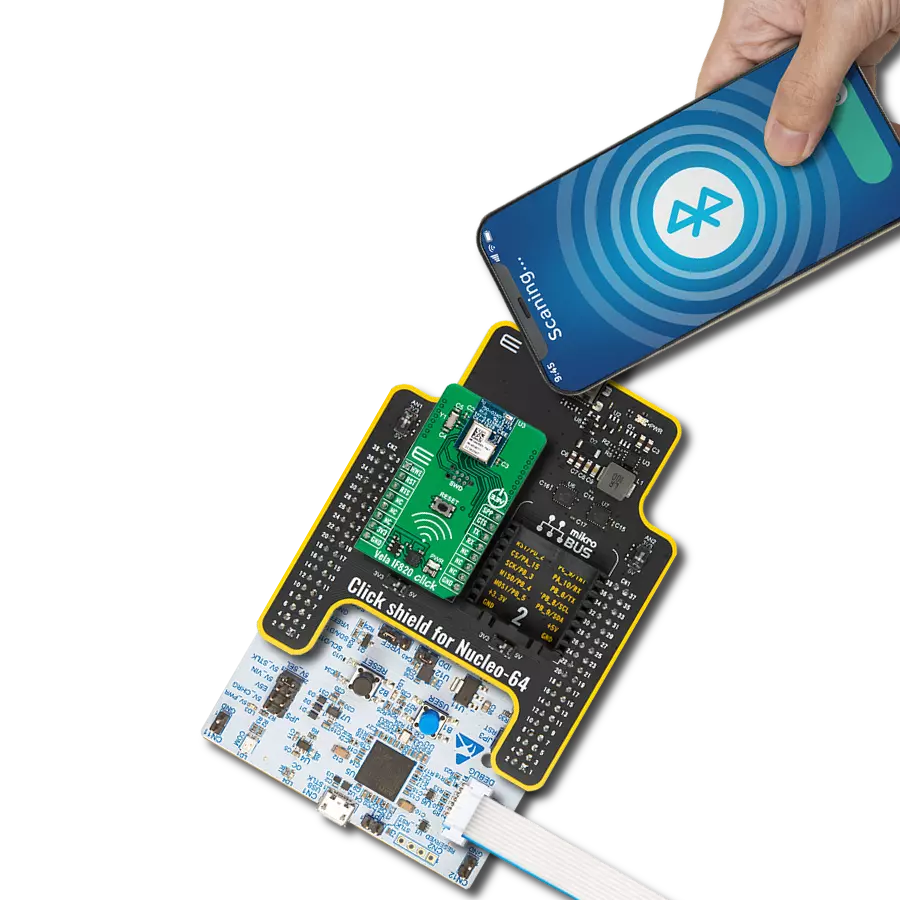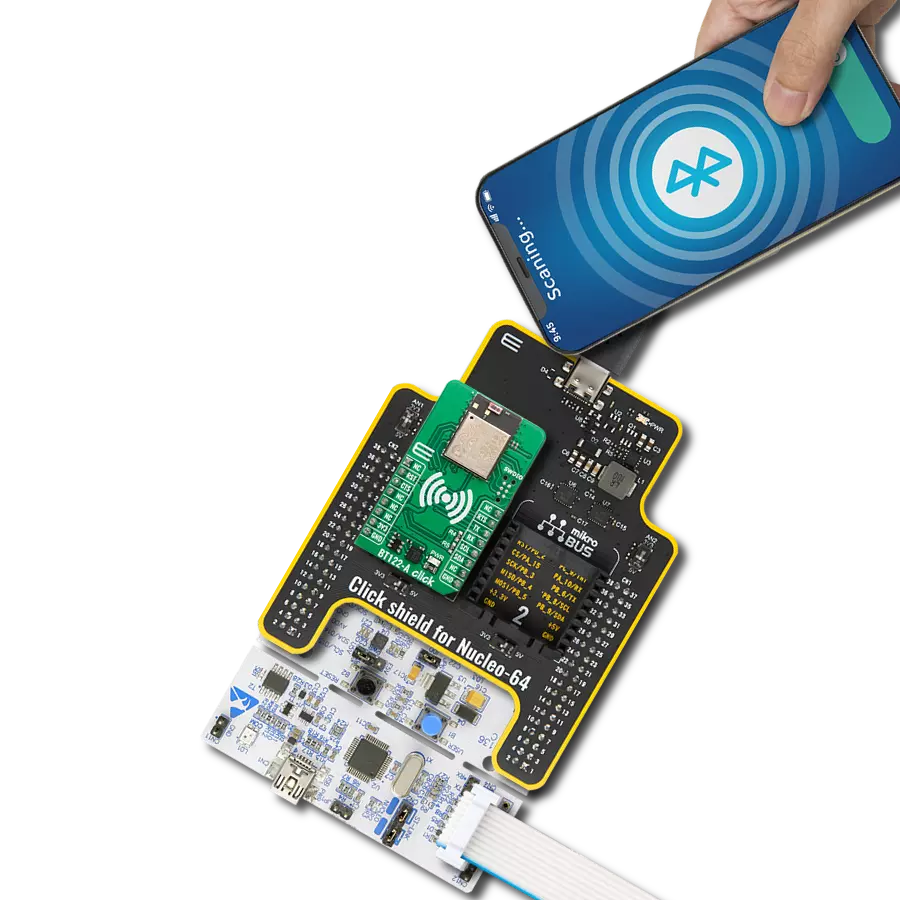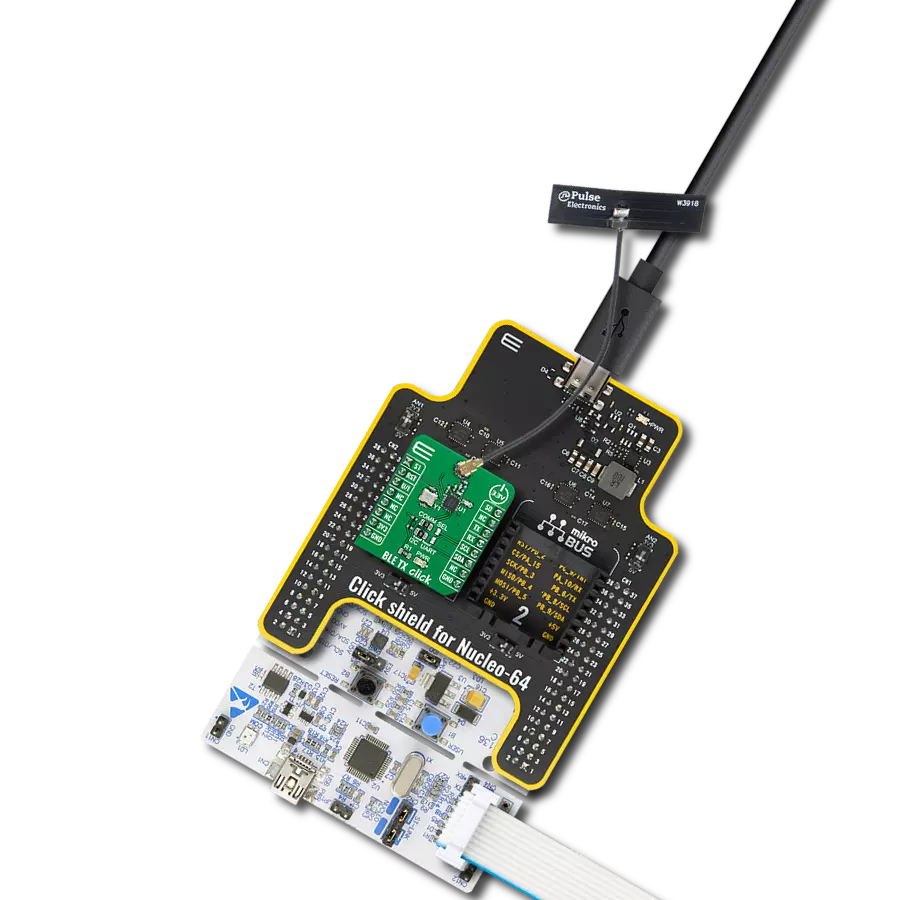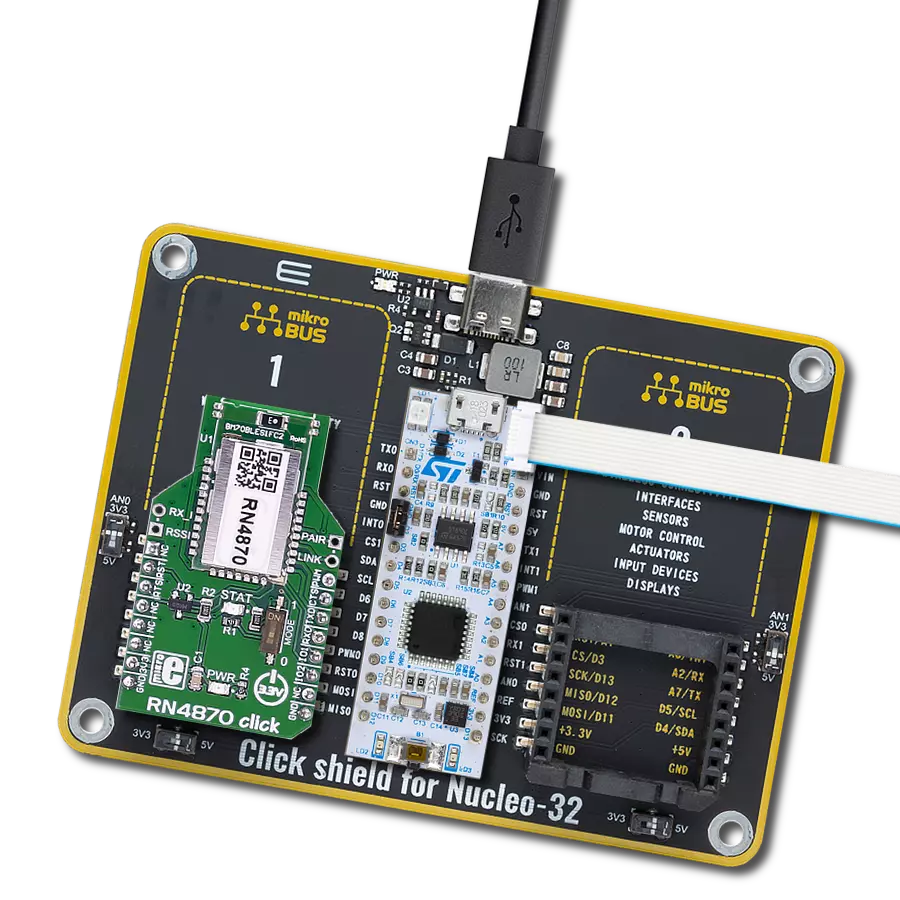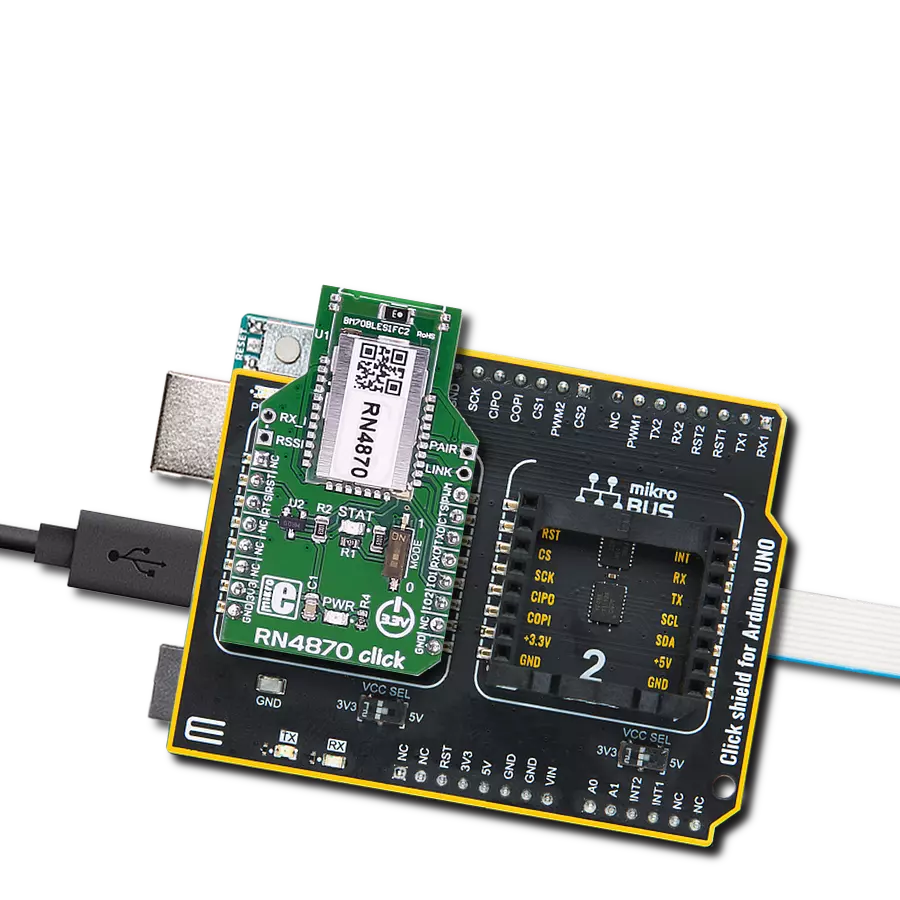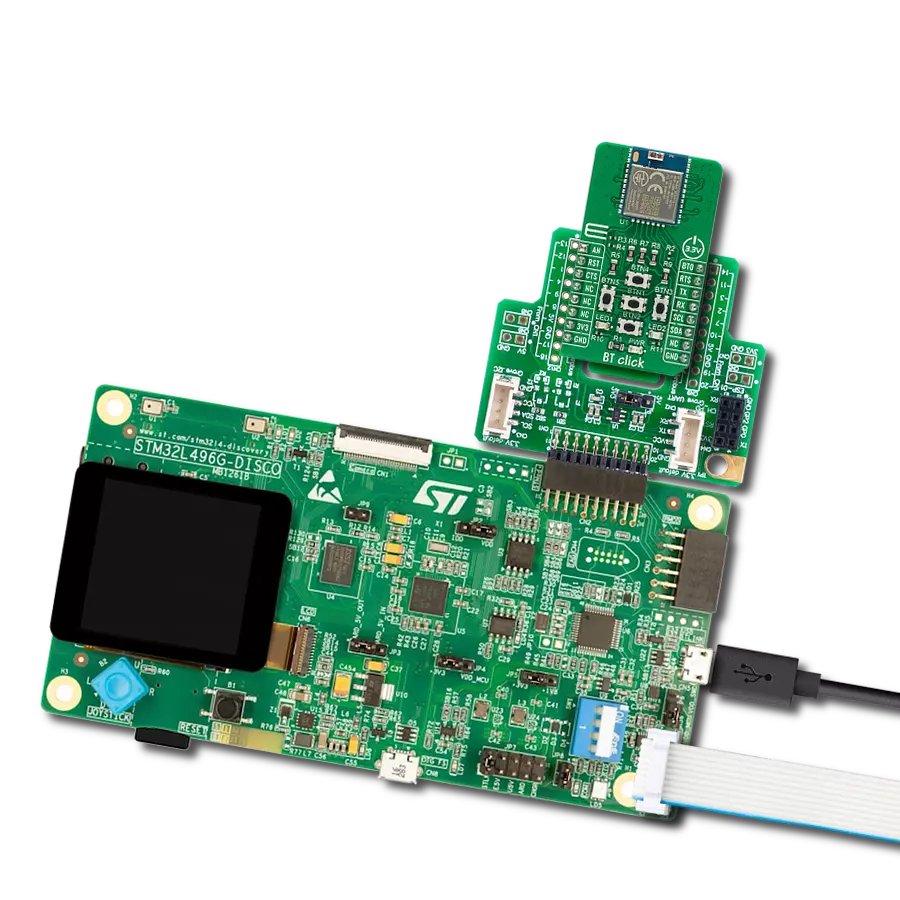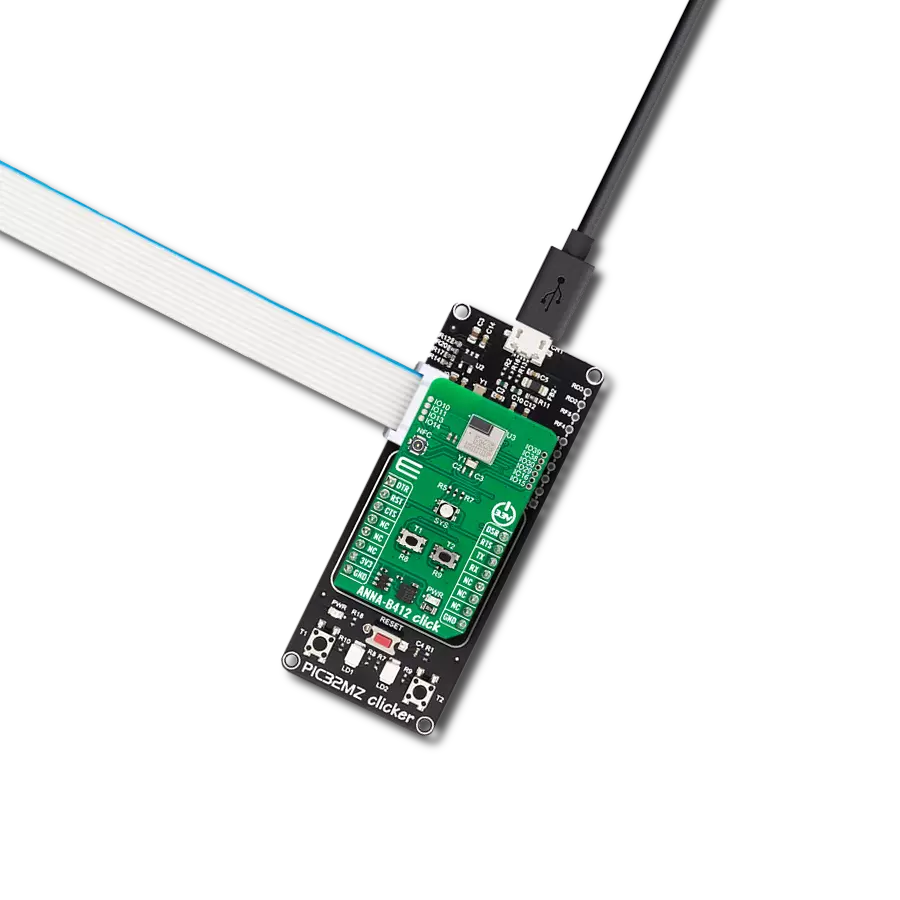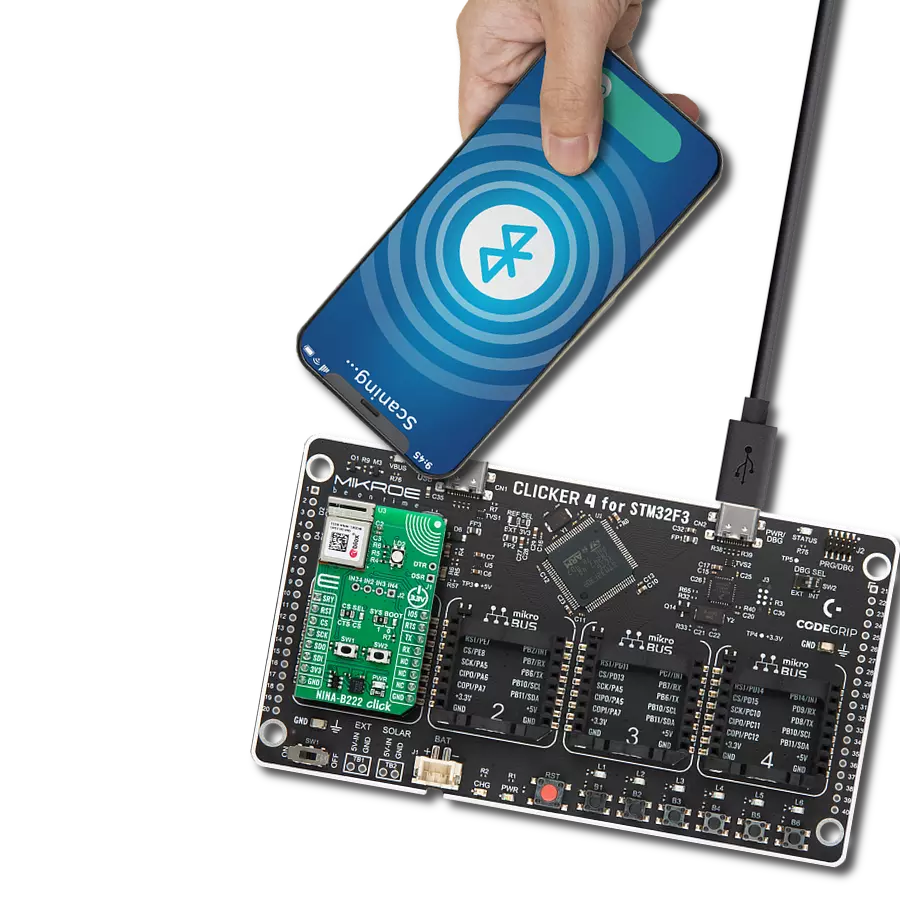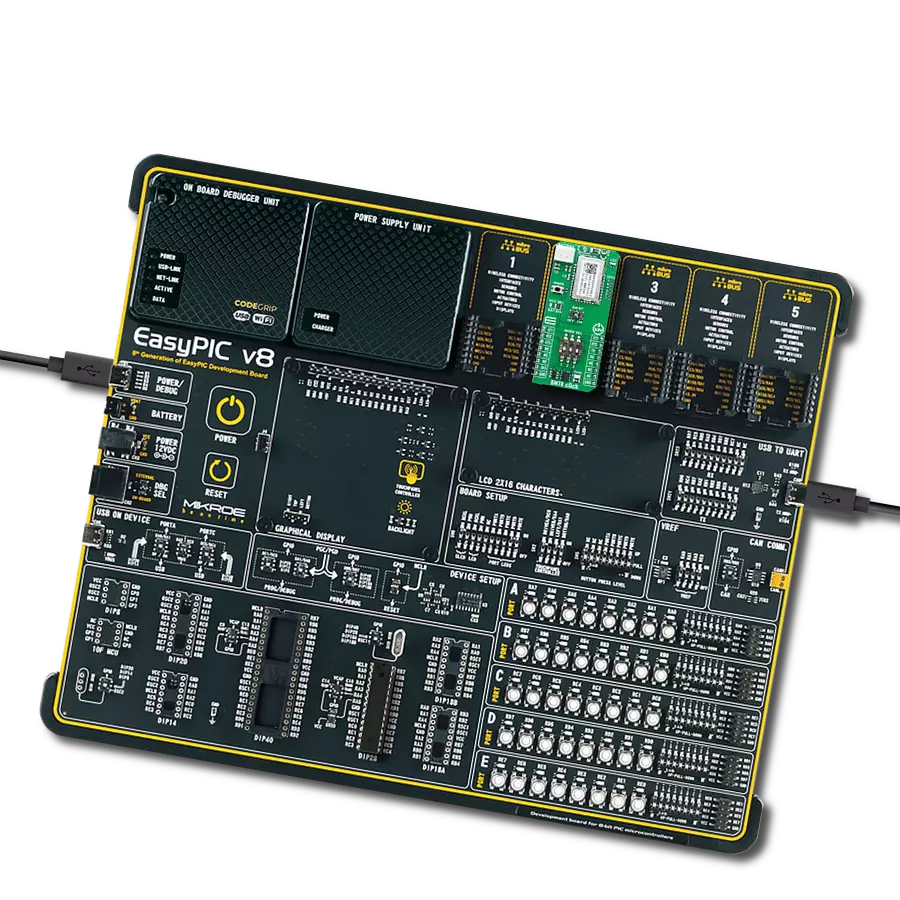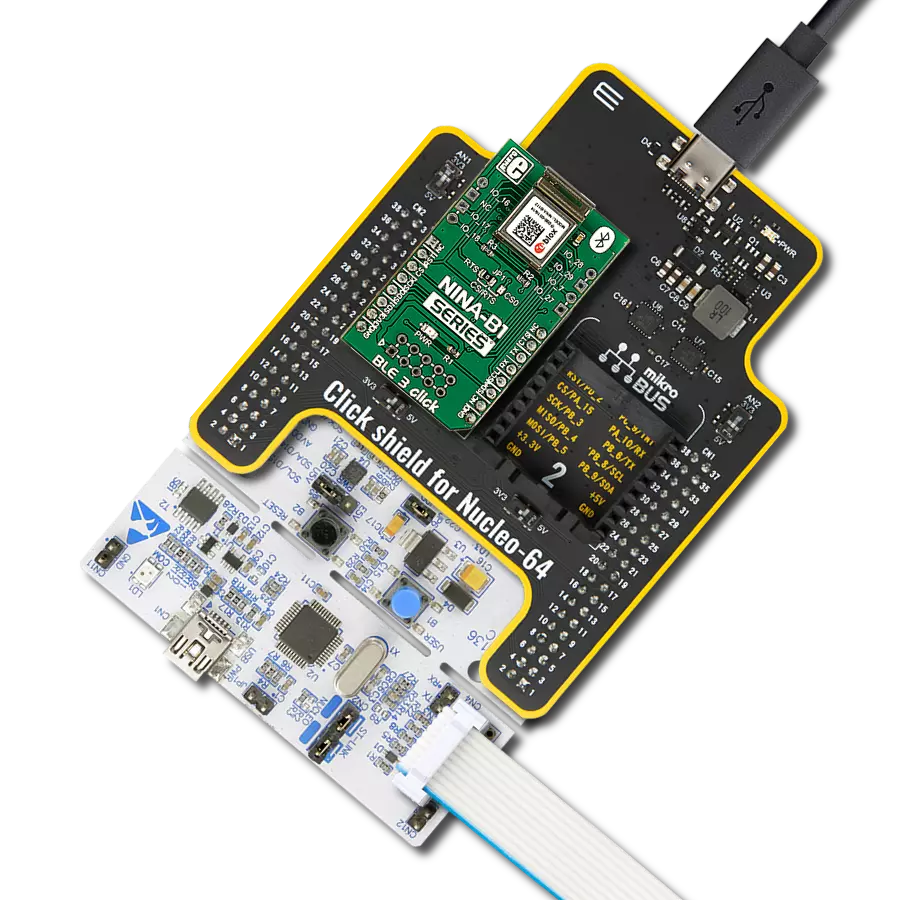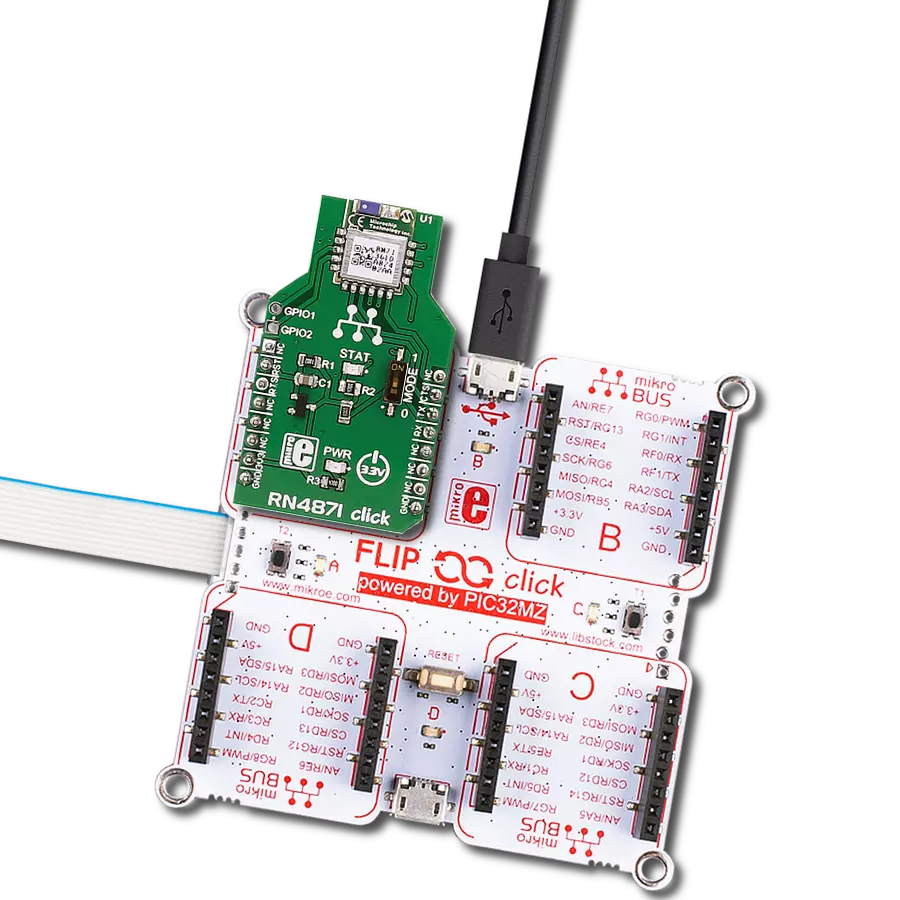Our Bluetooth 5.1 LE solution ensures a robust link between devices while optimizing energy usage, delivering a superior wireless experience
A
A
Hardware Overview
How does it work?
ANNA-B412 Click is based on the ANNA-B412, a standalone Bluetooth 5.1 low-energy module from u-blox. Under the metal hood, all the hard work is done by the nRF52833 from Nordic Semiconductor, which includes an integrated 2.4GHz transceiver with +8dBm output power and powerful Arm Cortex-M4 with FPU processor. In addition, it is equipped with 512KB of flash memory and 128KB of RAM. For a Bluetooth connection in a 2.4GHz frequency band, ANNA-B412 Click is equipped with a printed PCB antenna with support for 40 channels. The Bluetooth antenna has +9dBm of maximum radiated output power. For NFC, ANNA-B412 Click is equipped with a u.Fl connector, and can operate as a 13.56MHz NFC tag at a bit rate of 106Kbps. One of the main features of this module is the Angle of Arrival (AoA) and Angle of Departure (AoD) with the support of
a Bluetooth 5.1 Direction Finding service. These features can be used for indoor positioning, wayfinding, asset tracking, and more. The module supports Active, Standby, and Sleep modes to optimize power consumption. Two buttons (T1 and T2) can control the system. By combining these buttons while operating or during Power-Up, you can restore settings to their default values, open a Bluetooth LE connection to a peripheral device, enter bootloader mode, or exit the bootloader mode and restore all settings to their factory default values. The onboard RGB LED notifies the system status signals, which can be idle in Data mode/Extended data mode, idle in Command mode, connecting, and connected. In addition, ANNA-B412 Click is equipped with ten u-connectXpress IO pins, separated into two headers, which can be used for user configurable
purposes. ANNA B412 Click uses a 4-Wire UART interface to communicate with the host MCU with a commonly used UART RX/TX and UART RTS/ CTS as UART control flow pins. In addition, the UART DTR data terminal ready and the UART DSR data set ready are also available. The default baud rate is 115200bps. The RST pin can be used to reset the module with active LOW. Besides the library we provide, you can use a set of AT commands to control the ANNA B-412 module over the UART interface. This Click board™ can be operated only with a 3.3V logic voltage level. The board must perform appropriate logic voltage level conversion before using MCUs with different logic levels. Also, this Click board™ comes equipped with a library containing easy-to-use functions and an example code that can be used as a reference for further development.
Features overview
Development board
Nucleo-64 with STM32F091RC MCU offers a cost-effective and adaptable platform for developers to explore new ideas and prototype their designs. This board harnesses the versatility of the STM32 microcontroller, enabling users to select the optimal balance of performance and power consumption for their projects. It accommodates the STM32 microcontroller in the LQFP64 package and includes essential components such as a user LED, which doubles as an ARDUINO® signal, alongside user and reset push-buttons, and a 32.768kHz crystal oscillator for precise timing operations. Designed with expansion and flexibility in mind, the Nucleo-64 board features an ARDUINO® Uno V3 expansion connector and ST morpho extension pin
headers, granting complete access to the STM32's I/Os for comprehensive project integration. Power supply options are adaptable, supporting ST-LINK USB VBUS or external power sources, ensuring adaptability in various development environments. The board also has an on-board ST-LINK debugger/programmer with USB re-enumeration capability, simplifying the programming and debugging process. Moreover, the board is designed to simplify advanced development with its external SMPS for efficient Vcore logic supply, support for USB Device full speed or USB SNK/UFP full speed, and built-in cryptographic features, enhancing both the power efficiency and security of projects. Additional connectivity is
provided through dedicated connectors for external SMPS experimentation, a USB connector for the ST-LINK, and a MIPI® debug connector, expanding the possibilities for hardware interfacing and experimentation. Developers will find extensive support through comprehensive free software libraries and examples, courtesy of the STM32Cube MCU Package. This, combined with compatibility with a wide array of Integrated Development Environments (IDEs), including IAR Embedded Workbench®, MDK-ARM, and STM32CubeIDE, ensures a smooth and efficient development experience, allowing users to fully leverage the capabilities of the Nucleo-64 board in their projects.
Microcontroller Overview
MCU Card / MCU
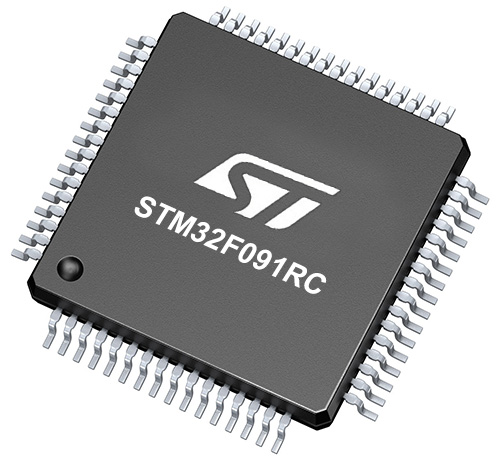
Architecture
ARM Cortex-M0
MCU Memory (KB)
256
Silicon Vendor
STMicroelectronics
Pin count
64
RAM (Bytes)
32768
You complete me!
Accessories
Click Shield for Nucleo-64 comes equipped with two proprietary mikroBUS™ sockets, allowing all the Click board™ devices to be interfaced with the STM32 Nucleo-64 board with no effort. This way, Mikroe allows its users to add any functionality from our ever-growing range of Click boards™, such as WiFi, GSM, GPS, Bluetooth, ZigBee, environmental sensors, LEDs, speech recognition, motor control, movement sensors, and many more. More than 1537 Click boards™, which can be stacked and integrated, are at your disposal. The STM32 Nucleo-64 boards are based on the microcontrollers in 64-pin packages, a 32-bit MCU with an ARM Cortex M4 processor operating at 84MHz, 512Kb Flash, and 96KB SRAM, divided into two regions where the top section represents the ST-Link/V2 debugger and programmer while the bottom section of the board is an actual development board. These boards are controlled and powered conveniently through a USB connection to program and efficiently debug the Nucleo-64 board out of the box, with an additional USB cable connected to the USB mini port on the board. Most of the STM32 microcontroller pins are brought to the IO pins on the left and right edge of the board, which are then connected to two existing mikroBUS™ sockets. This Click Shield also has several switches that perform functions such as selecting the logic levels of analog signals on mikroBUS™ sockets and selecting logic voltage levels of the mikroBUS™ sockets themselves. Besides, the user is offered the possibility of using any Click board™ with the help of existing bidirectional level-shifting voltage translators, regardless of whether the Click board™ operates at a 3.3V or 5V logic voltage level. Once you connect the STM32 Nucleo-64 board with our Click Shield for Nucleo-64, you can access hundreds of Click boards™, working with 3.3V or 5V logic voltage levels.
Used MCU Pins
mikroBUS™ mapper
Take a closer look
Click board™ Schematic

Step by step
Project assembly
Software Support
Library Description
This library contains API for ANNA-B412 Click driver.
Key functions:
annab412_set_cmd_conn_mode- ANNA-B412 set connectability mode function.annab412_set_cmd_discover_mode- ANNA-B412 set discoverability mode function.annab412_set_cmd_device_name- ANNA-B412 set device name function.
Open Source
Code example
The complete application code and a ready-to-use project are available through the NECTO Studio Package Manager for direct installation in the NECTO Studio. The application code can also be found on the MIKROE GitHub account.
/*!
* @file main.c
* @brief ANNA-B412 Click Example.
*
* # Description
* This example demonstrates the use of ANNA-B412 Click board by processing
* the incoming data and displaying them on the USB UART.
*
* The demo application is composed of two sections :
*
* ## Application Init
* Initializes the driver and performs the Click default configuration.
*
* ## Application Task
* Reads and processes all incoming data and displays them on the USB UART.
*
* ## Additional Function
* - static void annab412_clear_app_buf ( void )
* - static err_t annab412_process ( annab412_t *ctx )
* - static err_t annab412_display_rsp ( char *rsp_end )
*
* @note
* We have used the BLE Scanner smartphone application for the test.
*
* @author Nenad Filipovic
*
*/
#include "board.h"
#include "log.h"
#include "annab412.h"
#define PROCESS_BUFFER_SIZE 200
#define DEVICE_NAME "ANNA-B412 Click"
#define RSP_TIMEOUT 20000
#define RSP_OK "OK"
static annab412_t annab412;
static log_t logger;
static uint8_t app_buf[ PROCESS_BUFFER_SIZE ] = { 0 };
static int32_t app_buf_len = 0;
/**
* @brief ANNA-B412 clearing application buffer.
* @details This function clears memory of application buffer and reset its length.
* @note None.
*/
static void annab412_clear_app_buf ( void );
/**
* @brief ANNA-B412 data reading function.
* @details This function reads data from device and concatenates data to application buffer.
* @param[in] ctx : Click context object.
* See #annab412_t object definition for detailed explanation.
* @return @li @c 0 - Read some data.
* @li @c -1 - Nothing is read.
* See #err_t definition for detailed explanation.
* @note None.
*/
static err_t annab412_process ( annab412_t *ctx );
/**
* @brief ANNA-B412 display response function.
* @details This function reads data from device until sends @a rsp_end or ERROR message or until
* it exceeds the timeout value.
* @param[in] rsp_end : Response/Event ending string
* @return @li @c 0 - Read some data.
* @li @c -1 - Nothing is read.
* See #err_t definition for detailed explanation.
* @note None.
*/
static err_t annab412_display_rsp ( char *rsp_end );
void application_init ( void )
{
log_cfg_t log_cfg; /**< Logger config object. */
annab412_cfg_t annab412_cfg; /**< Click config object. */
/**
* Logger initialization.
* Default baud rate: 115200
* Default log level: LOG_LEVEL_DEBUG
* @note If USB_UART_RX and USB_UART_TX
* are defined as HAL_PIN_NC, you will
* need to define them manually for log to work.
* See @b LOG_MAP_USB_UART macro definition for detailed explanation.
*/
LOG_MAP_USB_UART( log_cfg );
log_init( &logger, &log_cfg );
log_info( &logger, " Application Init " );
// Click initialization.
annab412_cfg_setup( &annab412_cfg );
ANNAB412_MAP_MIKROBUS( annab412_cfg, MIKROBUS_1 );
if ( UART_ERROR == annab412_init( &annab412, &annab412_cfg ) )
{
log_error( &logger, " Communication init." );
for ( ; ; );
}
if ( ANNAB412_ERROR == annab412_default_cfg ( &annab412 ) )
{
log_error( &logger, " Default configuration." );
for ( ; ; );
}
Delay_ms ( 1000 );
annab412_set_cmd_echo_on( &annab412 );
annab412_display_rsp( RSP_OK );
Delay_ms ( 100 );
annab412_set_cmd_device_name( &annab412, DEVICE_NAME );
annab412_display_rsp( RSP_OK );
Delay_ms ( 100 );
annab412_set_cmd_discover_mode( &annab412, ANNAB412_DISCOVERABLE_MODE_ON );
annab412_display_rsp( RSP_OK );
Delay_ms ( 100 );
annab412_set_cmd_enter_mode( &annab412, ANNAB412_ENTER_MODE_DATA );
annab412_display_rsp( RSP_OK );
Delay_ms ( 100 );
annab412_set_dsr_pin( &annab412, ANNAB412_PIN_STATE_LOW );
Delay_ms ( 100 );
}
void application_task ( void )
{
annab412_process( &annab412 );
if ( app_buf_len > 0 )
{
log_printf( &logger, "%s", app_buf );
annab412_clear_app_buf( );
}
}
int main ( void )
{
/* Do not remove this line or clock might not be set correctly. */
#ifdef PREINIT_SUPPORTED
preinit();
#endif
application_init( );
for ( ; ; )
{
application_task( );
}
return 0;
}
static void annab412_clear_app_buf ( void )
{
memset( app_buf, 0, app_buf_len );
app_buf_len = 0;
}
static err_t annab412_process ( annab412_t *ctx )
{
uint8_t rx_buf[ PROCESS_BUFFER_SIZE ] = { 0 };
int32_t rx_size = 0;
rx_size = annab412_generic_read( ctx, rx_buf, PROCESS_BUFFER_SIZE );
if ( rx_size > 0 )
{
int32_t buf_cnt = app_buf_len;
if ( ( ( app_buf_len + rx_size ) > PROCESS_BUFFER_SIZE ) && ( app_buf_len > 0 ) )
{
buf_cnt = PROCESS_BUFFER_SIZE - ( ( app_buf_len + rx_size ) - PROCESS_BUFFER_SIZE );
memmove ( app_buf, &app_buf[ PROCESS_BUFFER_SIZE - buf_cnt ], buf_cnt );
}
for ( int32_t rx_cnt = 0; rx_cnt < rx_size; rx_cnt++ )
{
if ( rx_buf[ rx_cnt ] )
{
app_buf[ buf_cnt++ ] = rx_buf[ rx_cnt ];
if ( app_buf_len < PROCESS_BUFFER_SIZE )
{
app_buf_len++;
}
}
}
return ANNAB412_OK;
}
return ANNAB412_ERROR;
}
static err_t annab412_display_rsp ( char *rsp_end )
{
uint32_t timeout = RSP_TIMEOUT;
annab412_clear_app_buf( );
while ( timeout-- )
{
annab412_process( &annab412 );
if ( app_buf_len > 0 )
{
for ( int32_t buf_cnt = 0; buf_cnt < app_buf_len; buf_cnt++ )
{
log_printf( &logger, "%c", app_buf[ buf_cnt ] );
}
if ( strstr( app_buf, rsp_end ) )
{
annab412_clear_app_buf( );
Delay_ms ( 100 );
annab412_process( &annab412 );
for ( int32_t buf_cnt = 0; buf_cnt < app_buf_len; buf_cnt++ )
{
log_printf( &logger, "%c", app_buf[ buf_cnt ] );
}
annab412_clear_app_buf( );
log_printf( &logger, "--------------------------------\r\n" );
return ANNAB412_OK;
}
}
Delay_ms ( 1 );
}
return ANNAB412_ERROR;
}
// ------------------------------------------------------------------------ END
Additional Support
Resources
Category:BT/BLE


















